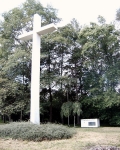Ostlandkreuz
Archaeology »
Archaeological Monuments » Ostlandkreuz
Ostlandkreuz - Germany
Ostlandkreuz is located in Schorndorf.
Ostlandkreuz monument was established on 1950.
Primary threats to Ostlandkreuz :
Ostlandkreuz is the name of memorial crosses in Germany remembering the expulsion of Germans after World War II from the former Sudetenland areas of Czechoslovakia, from Poland and the Soviet part of the former Province of East Prussia.
Historical facts of Ostlandkreuz :
- The Ostlandkreuz monument, established in 1950, stands as a significant symbol of remembrance and historical significance. Located in the heart of Ostlandkreuz, a town with a rich history, the monument serves as a constant reminder of the past events that shaped the region and the sacrifices made by its inhabitants.
- The establishment of the Ostlandkreuz monument was a response to the need for a tangible memorial to commemorate the tumultuous events of the past. Ostlandkreuz itself had endured several significant historical moments that shaped its identity. The monument was envisioned as a way to honor the town's history and pay tribute to those who had contributed to its development.
- One of the most important historical facts associated with the Ostlandkreuz monument is its connection to World War II. The town, like many others in the region, suffered greatly during the war. It witnessed intense battles, occupation, and the subsequent liberation. The monument serves as a testament to the resilience and courage of the people who endured these hardships.
- Additionally, the Ostlandkreuz monument also symbolizes the post-war period of reconstruction and the collective effort to rebuild the town. After the war, Ostlandkreuz faced numerous challenges, including the need for infrastructure repair, rebuilding homes, and reviving the local economy. The monument stands as a symbol of unity and determination, reflecting the town's commitment to moving forward and rebuilding.
- Furthermore, the Ostlandkreuz monument holds historical significance beyond the immediate post-war period. It serves as a reminder of the region's cultural heritage and its long-standing traditions. The monument incorporates elements of local folklore, traditional architecture, and symbolic motifs that represent the town's historical roots.
- Another significant aspect of the Ostlandkreuz monument is its role in fostering a sense of community and collective memory. It serves as a gathering place for locals and visitors alike, allowing them to reflect on the town's history and pay tribute to those who came before. The monument often becomes a focal point for ceremonies, commemorations, and cultural events, further strengthening the community's bond.
- Over the years, the Ostlandkreuz monument has become an iconic landmark, attracting tourists and historians from around the world. It offers visitors the opportunity to delve into the rich history of the town and gain a deeper understanding of the events that shaped it. The monument's architecture, design, and historical artifacts displayed in its vicinity contribute to an immersive experience, providing a glimpse into the past.
- In conclusion, the Ostlandkreuz monument stands as a testament to the rich history of the town and the resilience of its people. Established in 1950, it serves as a symbol of remembrance, commemorating the sacrifices made during World War II and the subsequent efforts to rebuild and revitalize the region. Through its architectural design, cultural symbolism, and role as a gathering place, the monument fosters a sense of community and collective memory. As a prominent landmark, it attracts visitors and historians, offering them the opportunity to delve into Ostlandkreuz's captivating past.

